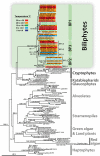Widespread distribution of a unique marine protistan lineage
- PMID: 18341584
- PMCID: PMC2408648
- DOI: 10.1111/j.1462-2920.2008.01580.x
Widespread distribution of a unique marine protistan lineage
Abstract
Unicellular eukaryotes (protists) are key components of marine food webs, yet knowledge of their diversity, distributions and respective ecologies is limited. We investigated uncultured protists using 18S rRNA gene sequencing, phylogenetic analyses, specific fluorescence in situ hybridization (FISH) probes and other methods. Because few studies have been conducted in warm water systems, we focused on two Atlantic subtropical regions, the Sargasso Sea and the Florida Current. Cold temperate waters were also sampled. Gene sequences comprising a unique eukaryotic lineage, herein termed 'biliphytes', were identified in most samples, whether from high- (30 degrees C) or from low- (5 degrees C) temperature waters. Sequences within this uncultured group have previously been retrieved from high latitudes. Phylogenetic analyses suggest biliphytes are a sister group to the cryptophytes and katablepharids, although the relationship is not statistically supported. Bootstrap-supported subclades were delineated but coherence was not obvious with respect to geography or physicochemical parameters. Unlike results from the initial publication on these organisms (therein 'picobiliphytes'), we could not detect a nucleomorph, either visually, or by targeted primers. Phycobilin-like fluorescence associated with biliphyte-specific FISH-probed cells supports the hypothesis that they are photosynthetic. Our data indicate the biliphytes are nanoplanktonic in size, averaging 4.1 +/- 1.0 x 3.5 +/- 0.8 microm (+/-SD) for one probed group, and 3.5 +/- 0.9 x 3.0 +/- 0.9 microm (+/-SD) for another. We estimate biliphytes contributed 28 (+/-6)% of the phytoplanktonic biomass in tropical eddy-influenced surface waters. Given their broad thermal and geographic distribution, understanding the role these protists play in biogeochemical cycling within different habitats is essential.
Figures


References
-
- Adl SM, Simpson AG, Farmer MA, Andersen RA, Anderson OR, Barta JR, et al. The new higher level classification of eukaryotes with emphasis on the taxonomy of protists. J Eukaryot Microbiol. 2005;52:399–451. - PubMed
-
- Archibald JM. Nucleomorph genomes: structure, function, origin and evolution. Bioessays. 2007;29:392–402. - PubMed
-
- Azam F, Worden A. Microbes, molecules, and marine ecosystems. Science. 2004;303:1622–1624. - PubMed
-
- Countway PD, Gast RJ, Savai P, Caron DA. Protistan diversity estimates based on 18S rDNA from seawater incubations in the western North Atlantic. J Eukary Microbiol. 2005;52:95–106. - PubMed
Publication types
MeSH terms
Substances
Associated data
- Actions
- Actions
- Actions
- Actions
- Actions
- Actions
- Actions
- Actions
- Actions
- Actions
- Actions
- Actions
- Actions
- Actions
- Actions
- Actions
- Actions
- Actions
- Actions
- Actions
- Actions
- Actions
- Actions
- Actions
- Actions
- Actions
- Actions
- Actions
- Actions
- Actions
- Actions
- Actions
- Actions
- Actions
- Actions
- Actions
- Actions
LinkOut - more resources
Full Text Sources
Molecular Biology Databases

